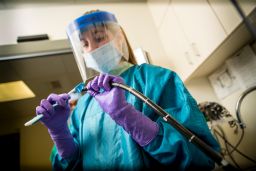Story highlights
FDA official says Olympus never got permission to sell its endoscope
Medical device is connected to CRE outbreak in California that's left two people dead
CNN has learned that the manufacturer of the endoscope involved in two superbug deaths at UCLA never obtained permission to sell the device, according to an official at the Food and Drug Administration.
Olympus started selling its TJF-Q180V duodenoscope in 2010, but the FDA didn’t notice until late 2013 or early 2014 that the company had never asked for clearance to put it on the market, according to Karen Riley, deputy director of strategy for the FDA’s Office of External Affairs.
“Why didn’t we notice it? I don’t know,” Riley said.
“Can you imagine a prescription drug getting out on the market that didn’t go through the approval process?” asked Dr. Steven Nissen, the chief of cardiovascular medicine at the Cleveland Clinic, who’s testified to Congress about device safety problems. “Devices need to be regulated more vigorously. This is really disturbing.”
In a statement, Olympus said it didn’t think needed the FDA’s permission to sell the device, but now at the request of the agency, it has applied for that permission. That application is still pending.
Outbreak started at UCLA
Seven hospital patients at Ronald Reagan UCLA Medical Center were infected with the deadly superbug CRE – also known as carbapenem-resistant Enterobacteriaceae – from October to January, according to hospital officials. Two of those patients died.
The patients caught CRE after routine endoscopic treatments. Hospital officials believe two medical scopes that still carried the deadly bacteria even after disinfection guidelines were followed were the cause of the superbug outbreak.
The medical center has contacted 179 others who had endoscopic procedures between October and January and is offering them home tests to screen for the bacteria.
Four other patients at Cedars-Sinai Medical Center in Los Angeles have also been infected with the superbug linked to a contaminated duodenoscope, according to a statement released by the hospital. The medical scope was used in all four patients, between August and January 2015. Sixty-four other patients who had a duodenoscope procedure with that particular scope are being informed by mail, “out of an abundance of caution.”
Not safer
According to FDA rules, a manufacturer must seek clearance for a new model if it includes changes that “could significantly affect the safety or effectiveness of the device.”

The TJF-Q180V duodenoscope, used to check out ducts in the gastrointestinal system, includes a modification to the exact part of the device that’s been implicated in the superbug outbreaks.
With this new model, Olympus sealed up that part of the device, known as the elevator channel, hoping to make it more impervious to infection.
“The company clearly made these modifications to make the device safer, but it seems to be that it wasn’t safer,” Riley said.
Last year, at the FDA’s request, Olympus applied for permission to sell the scope. That application is still pending.
Riley emphasized that duodenoscope procedures can be lifesaving, so the agency doesn’t want to take them off the market.
“More than 500,000 of these procedures are done every year in the U.S., and the risk of bacterial transmission is actually really very, very low,” she said. “We believe the benefits outweigh the risks.”
In its statement, Olympus wrote: “The emergence of drug-resistant microorganisms is a challenge to the entire health care community. Olympus is working with relevant medical societies and our customers in research of this emerging issue and the development of additional safeguards to prevent infection associated with [duodenoscope procedures].”
Riley noted that the other two duodenoscope manufacturers, Pentax and Fujifilm, did apply for and were granted clearance to market models similar to Olympus’ TJF-Q180V.
Not clean enough
Now the FDA is asking all three companies to submit evidence that the scopes can be thoroughly cleaned – and so far it’s not going well.
Riley said twice the companies have submitted data that failed to show that cleaning could get rid of 99.9999% of all microbes on the scope – the FDA’s standard for disinfection.
“We’re still working with them to get good data,” she said.
Riley said she doesn’t know if the FDA will penalize Olympus for selling the device without permission.
Diana Zuckerman, a device safety expert, said they should.
“It’s like with kids. How do you teach your children to behave if there are no consequences when they misbehave?” she said.

















